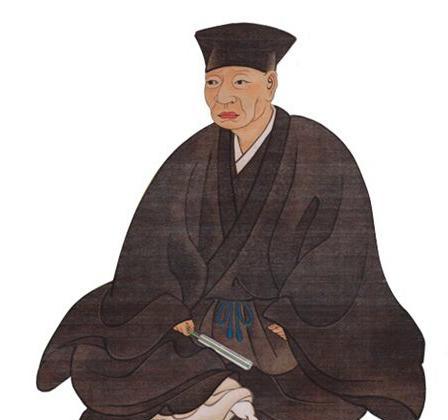Text | Deacons
The Japanese tea ceremony was originally completely modeled after the Chinese tea ceremony, and the localization of the tea ceremony was achieved through the improvement of Noh Ami and Zhuguang's apprentices, so that the tea ceremony in this island country suspended in the northwest Pacific Ocean had a different style from its birthplace. No less than China's Jida Tebo, the inheritance of the Japanese tea ceremony can almost be traced back to the two people of Noh Ami and Zhuguang in the end, and the same is true of Senritsu, the "world's first tea maker" and the master of the Japanese tea ceremony.

Born into a machi family, Senritsu began to study tea ceremony from an early age under the tutelage of tea soup celebrity Takeno Shoo. Shao Ou successively studied with Zhu Guang's three disciples, so Shao Ou and Qian Li Xiu could naturally be regarded as Zhu Guang's disciples. After Shogo's death, Japan had entered the Sengoku period, when the tea ceremony included three of the most famous tea people, collectively known as the "Three Craftsmen of the World", including Senritsu and his rival Imai Munehisa. The difference between Senritsu and Imai Sohisa is mainly due to the spirit of the tea ceremony between the two: Senritsu pays attention to the connotation and despises the procedure, and even the taizi that Nomi has improved is regarded as a useless thing, and completely establishes the banner of "Yu"; while Imai Munaku pays attention to the procedure, and his taizi tea ordering method is the first in the world. During the time of Oda Nobunaga, the two attacked each other, but were able to live in peace; it was not until the time of Toyotomi Hideyoshi that the great war that determined their fate arrived.
Both Chiritsu and Imai Sokisa were Toyotomi Hideyoshi's "tea heads" at the time, and one day Toyotomi Hideyoshi suddenly ordered the two to perform a tour to order tea—in fact, the two of them competed in the art of making tea. In the Warring States period, the tea art between tea people was similar to the samurai competition, and it was almost necessary to fight for their lives, so this time the tour of tea was almost the pinnacle of the tea ceremony.
Senritsu wanted to despise the "metaphysical" tea ordering method, and in order to cope with the competition, he had to go to the same door to "make up"; while the terrace tea order was Imai Sohisa's trump card, and the victory and defeat of the two seemed to have been predestined. However, on the day of ordering tea, Qian Lixiu drastically deleted the tea order method and staged a new set of tea ordering methods in a smooth manner. Toyotomi Hidetoshi was extremely surprised and questioned Senritsu, but Senritsu said indifferently, "The ancient stream is cumbersome, so the face is simple." This move actually caused Imai Zongjiu to fall into chaos, so that he made a mistake in ordering tea, spilling tea on the edge of the tea bowl. As a result, the victory and defeat were reversed, and Senritsu, who opposed tea ordering, defeated Imai Munehisa, who was famous for ordering tea, in the tea ordering competition, and became the world's first tea person.
After defeating Imai Munakata, Senritsu began the heyday of his life. Toyotomi Hideyoshi was so important that he consulted on domestic and foreign affairs; Senritsu was not only a tea head, but also a politician and courtier. At that time, in Osaka Castle, even the daimyo of various provinces were silent in front of Toyotomi Hideyoshi for fear of being offended by words, and the only "outsider" in the country who could talk to this world person at will was Senritsu. In this case, various daimyo became the tea ceremony disciples of Senritsu - of course, this is not just a simple worship of the teacher, with Senritsu, there is also a channel for indirect communication with Toyotomi Hideyoshi, as a tea person, although his qilu only has three thousand stones, but his status is already one person, and his merit is not rewarded.
What is good on the top will be worse for the bottom. With Senritsu, the tea ceremony also entered a heyday. The tea soup imported from China, through the efforts of generations of tea people in Neng Ami, finally infiltrated into all aspects of Japan with the power of Senritsu. However, things that prosper by power also describe the decline and fall of power, and the same is true of Senritsu and his tea ceremony.
Immediately after Toyotomi Hideyoshi pacified the world, he began to reform, and the hierarchy of scholars, farmers, and industrialists was formally formed in Japan. Prior to this, although the aristocratic and samurai classes also had a higher status, as a system, they were formed with the "World Buwu" of the Warring States Three Heroes. Senritsu was born into the "merchant" class, which undoubtedly trespassed the new order, and at this time, Toyotomi Hideyoshi also wanted to replace Senritsu's "equality of all beings" tea ceremony with a tea ceremony that conformed to the spirit of the new era, so the contradiction inevitably broke out.
The final outcome of this contradiction is that QianLixiu was urgently committed suicide for political reasons, and the Qianjia family fell silent; second, the tea ceremony that conformed to the spirit of the new era, the samurai tea ceremony, gradually developed. From the perspective of history, perhaps the success or failure of Qianli Xiu is neither the work of tea nor the sin of tea. His fame stems from the integration of the tea ceremony into the times, and his loss of power stems from the fact that the tea ceremony was abandoned by the times, and all this is not something that a tea person can control.